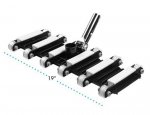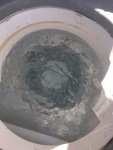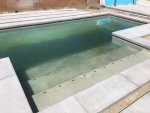My caveat first... I'm a general contractor, but not a plumber, and definitely not a pool plumber. I've done a lot of plumbing, that's all I can claim. So hopefully someone that knows more about this than me can corroborate. I'll just share what I know to be true about my pool, which sounds a lot like your pool, but I can't know that without looking at it.
If you have a port that is drawing water (sucking) when the pump is on, and it has threads like a return, and it is close-ish to the surface, that is most likely your vacuum port. Was a vacuum port spec'd in your plan?
So, a vacuum port without an approved cover on it violates code. ANSI code for one. You'd have to check with your building dept to figure out which code is the governing one, but regardless, an exposed suction port is dangerous, in terms of both entrapment and evisceration/disembowelment. There is supposed to be a safety flap. And another part of the code states that you're not supposed to apply suction to a vacuum port unless actively vacuuming with it. And there are not supposed to be humans in a pool with an exposed vacuum port. I'm paraphrasing from memory. All common sense one doesn't need a code for. You'll find similar warnings and codes if you google it.
I think my safety flap gizmo, which screws into my vacuum port threads, probably came with my Rebel vacuum (not sure, didn't install that myself). So that might be why yours is missing. And why the PG is using the skimmer, because there's nothing to attach his hose to at the vacuum port.
If it's like my pool, there will be a three way valve that balances the amount of flow between the vacuum port and the skimmer port. Sometimes that's done with two separate valves, but a three way is better because that mostly assures that the main pump's intake is open to one or the other, as opposed to both getting inadvertently closed somehow and then choking the pump.
I asked about the drain plumbing because if your drain is plumbed to the pad, and you have a dedicated vacuum port, you'd find at least three pipes all routing to the main pump: skimmer, vacuum and drain. If the drain is plumbed to the skimmer, then you might find only two at the pad: skimmer and vacuum. All of which should be labeled! Is it? Because you have a spa, you'll have other lines coming into pumps, too. But without examining your pad, I can't say. You may have a dedicated pump for the spa?
So you really need a tour of the equipment. Which they'll probably do at some point. Or you could ask for one now, I suppose. Regardless, that vacuum port should be closed if you and yours are swimming in the pool, either with a flap, a plug or with the valve, or some combination.
Anyway, if your skimmer is like mine, there's two big holes under the basket. One goes to the drains, the other to the pump. The latter is used for vacuuming. A sock won't catch the sand, because you have to remove the basket to get at the holes. I think there are gizmos that can connect a vacuum and still allow the basket, but unless you know you have one (and why would you, if you have a dedicated vacuum port), then Kim's sock trick isn't going to work for the sand. Personally (and this is where a TFP expert can help), I wouldn't worry about sand going to the filter. That's what its for. Your skimmer, skimmer basket, pump, pump basket and filter, your cleaning system, is designed to collect and trap debris, from the tiniest particle of dust to the biggest of leaves. Whatever makes it past the baskets ends up in the filter. You periodically take the filter apart and remove whatever made it that far. Simple. I'd follow what I learned here: let the filter do it's thing until its pressure gauge increases x amount, then clean it. If that's everyday, then fine. But if not, then no need to do it more often. What is "x amount?" Well, when you fire up your system, you set the desired RPMs for general filtering on your pump and then read the pressure gauge on the filter. That's your "clean filter" number. You monitor the pressure gauge (whenever the RPMs are in "general filtering" mode) until it goes above the recommended amount, then you change the filter and start over. The pressure will change with the RPMs, so in other modes (vacuum, high speed skimming, spa, etc) the pressure reading would be different. So you do your pressure comparison check apples to apples. You'd have to work with the PB to determine those numbers. TFP often recommends the amount of increase to watch for, but I hesitate to offer any numbers without better knowing your particular pool. Maybe someone else here will.
Now if you're talking about a LOT of sand, which is going to have to go through the pumps impeller to get to the filter, then maybe that's a concern? If you don't want any sand in your filter, I think the best option is an inline filter. It goes on the vacuum hose while vacuuming. I saw one on Amazon for about $50.
Regarding the test strips, yikes. We're right back to your best-practice vs PB warranty dilemma. If it were my pool, and I just did this, I'd ignore whatever the PG was telling me about water chemistry, and measure it myself and take charge of the balancing. But I didn't have a contract that stated anything about the PB owning the first 30 days. You have to keep the water balanced, especially now, and you have to let the PG do it?!? With test strips!?! Man. 'nother conversation with the sales guy, I guess. All you can do is express your concern, and the expectation that your water chemistry be determined by a proper test method (not strips) and that the chemistry adjustment be handled appropriately. But what I consider appropriate, and what your PB consider appropriate, will very like be two different things! I performed a drop test (or two) every day. It was only after a couple months that I started, sometimes, skipping a day. First 30 days (or longer) I adjusted chemistry every day. I worked my TA into range. My CH was already in range. I added CYA. I adjusted PH and TC every day. My startup was perfect in that regard. And to the extent that balance is critical to longevity, especially during the first 30 days, I know mine was as good as it gets. I don't see why you can't achieve the same, and expect that from your PB. I wouldn't want that all being done with strips, that's for sure. I think TFP would agree. They don't want everyday testing done with anything but the very best method. Certainly that would apply to the first 30 days! If your PB agrees, then he needs to get the PG on a better program. If he disagrees, well... have the conversation with him first. If it were my pool, I wouldn't let things stand as they are. I'm sure I've said this before: he'll be gone at the end of 30 days and will never look back. You'll be stuck with the results of any mishandled startup, which won't reveal itself until long after the warranty expires.
Other than that, have a great weekend! (Sorry for the Saturday morning downer.)
















